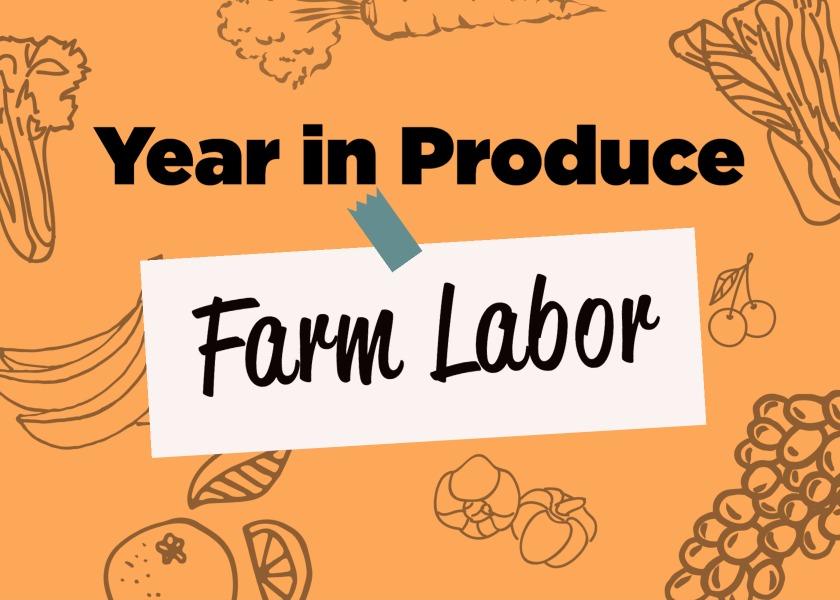Year in Produce No. 9 — Farm labor

While farm labor and immigration issues always rank near the top of industry concerns, the challenges to the agricultural employers have seldom been greater than in 2020.
The beginning of the COVID-19 pandemic in March came with fears about how the H-2A program could suffer under pandemic conditions. With mandates for reduced operations of U.S. consulates for in-person interviews, there were concerns about the processing of H-2A workers for entry into the U.S. Those fears were diminished with Trump administrations provisions that eased rules to allow in more agricultural workers on temporary H2A visas to help farmers with their crops.
As the pandemic increased its grip on the nation, there were more news reports about outbreaks of COVID-19 in the farm labor community, and follow-on reports about the measures that ag employers were taking to prevent the spread of the virus.
At the end of the year, the H-2A program was enveloped in a controversy about how the program would set its wage rate for 2021 and beyond.
Replacing the use of an annual farm labor to set H-2A wages, the Department of Labor created a new method of setting wages. Under that method, H-2A wages would hold at 2020 levels for 2021 and 2022, and then would be adjusted based in connection to wage inflation in the broader economy.
More regulations that would streamline the H-2A program for growers are expected in the final days of the Trump administration.
However, United Farm Workers sued the Trump administration on that new Department of Labor wage method, and that court challenge had not been resolved by the end of the year. The UFW also had sued the USDA, and under that lawsuit the USDA announced it would reinstate its farm labor survey that it had suspended in September, with the new report expected to be published in February
“It’s kind of a twisted road we are traveling,” said Michael Marsh, CEO of the National Council of Agricultural Employers.
Looking back at 2020, Marsh said that farmer advocates had entered the year feeling pretty good about prospects for immigration reform, as the House of Representatives in 2019 had passed immigration reform legislation, the first passed out of the House since 1986.
“We spent a good part of the January and into February working on a Senate version, and were looking at a companion bill coming out the Senate that could be a little grower-friendly,” Marsh said.
About a month later, President Trump declared a national emergency because of the pandemic and new issues began to demand attention.
Growers were looking to find protective equipment for their workers and put in place testing, but found they were competing against federal, state and local governments, first responders and more.
“It has been a year (of) challenge, and looking forward, I think one of the positives is we’ve been through it,” Marsh said. At the same time, various states have created different regulations around worker rules related to COVID-19, and that is making life more complicated for growers who have operations in different states.
What happens next with immigration and farm labor is an open question, but Marsh said growers are watching the makeup of the President-elect Biden’s cabinet.
“Secretary Vilsack has always been good to work with, and he’s got a good idea of what it takes for agricultural labor, and particularly labor intensive agriculture and so we’re pleased with that,” he said. “Hopefully this administration will be very positive to work with,” Marsh said.
Nov. 2
Trump administration releases new H-2A wage method
By Tom Karst
Stabilizing labor costs and adding more predictability, the Department of Labor’s H-2A wage rule is winning industry support.
U.S. Agriculture Secretary Sonny Perdue praised the final rule, which will become effective 45 days after publication in the Federal Register.
In a statement, the Florida Fruit & Vegetable Association commends the U.S. Department of Labor for extending the 2020 Adverse Effect Wage Rate through 2022. “We applaud the agency for recognizing that the USDA’s annual Farm Labor Survey was not the appropriate tool to determine wages for workers in the H-2A program,” the group said. “This change more closely matches market wage rates while not lowering wages for agricultural workers.”
FFVA said the measure holds wages stable during the transition period and provides “much-needed predictability” for agriculture employers who use the H-2A program.
The new method announced by the DOL should produce a more stable wage for the H-2A program, according to Michael Marsh, president and CEO of the National Council of Agricultural Employers. However, he said the rule could be subject to review if Democratic candidate Joe Biden wins the White House, he said.
Import competition, pandemic pose some problems for Florida fall produce







